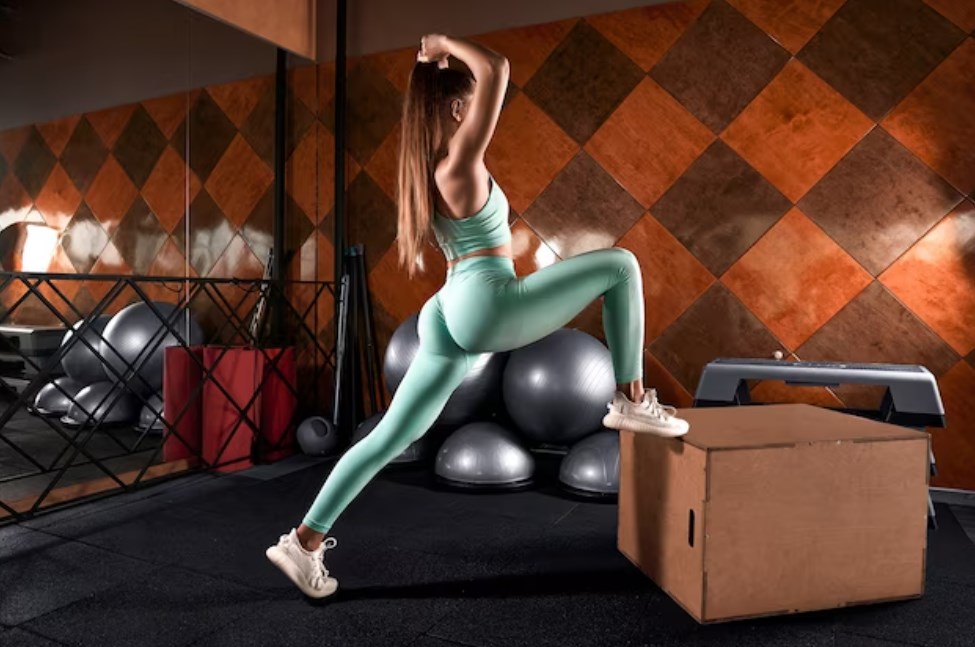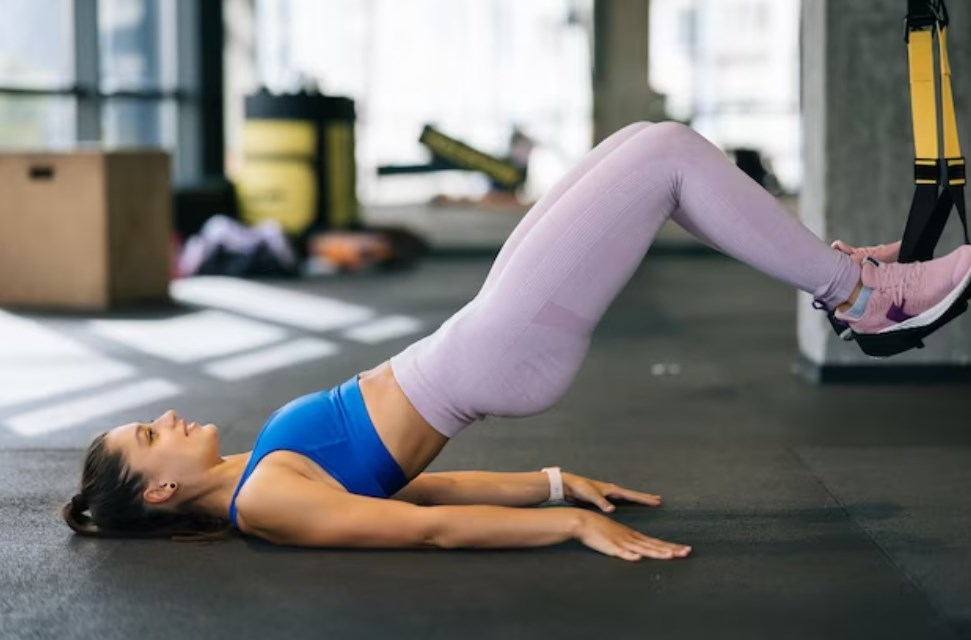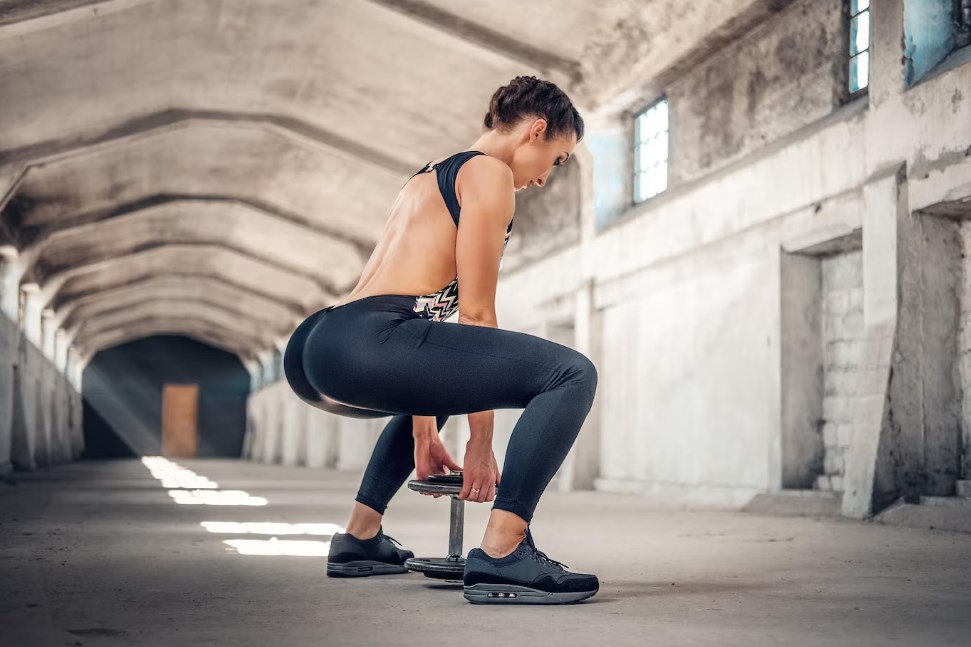A popular exercise for bolstering the gluteal muscles (GMs) is the hip thrust. However, for those seeking diversity or experiencing discomfort with this exercise, we present a series of effective alternatives.
By swapping hip thrusts with these substitutes, you can maintain a comprehensive lower body workout, build robust glutes, and ensure your exercise regimen is comfortable, safe, and efficient.
Understanding the Significance of Hip Thrusts in Glute Development
The hip thrust is celebrated as an effective way to strengthen and develop the GMs. If you find this exercise comfortable and achieve the desired outcomes, continuing with it can lead to a more robust and toned derriere.
Nevertheless, not everyone finds hip thrusts suitable for their workouts. Issues like lower back discomfort, difficulty engaging the GMs over other leg muscles, or an uncomfortable bar position may dissuade some individuals.
Yet, it remains essential to incorporate exercises that fortify the GMs into your workout regimen. Robust GMs can help reduce lower back problems, enhance hip stability, improve mobility, contribute to better squatting and deadlifting abilities, and of course, enhance the aesthetics of your backside.
In this article, we’ll delve into some of the top alternatives to hip thrusts that will keep your GMs active and strengthening.
Grasping the Basics of a Barbell Hip Thrust
The Barbell hip thrust is an exercise primarily focusing on your GMs and hamstrings. The exercise involves positioning a barbell across your pelvis, resting your shoulders on a bench, bending your knees to 90 degrees, and propelling upwards by engaging the glutes while maintaining a neutral spine.
GMs, being among the most robust muscles in the human body, can handle significant weight, given the correct form. Boosting the strength of these muscles can enhance your hip drive, contributing positively to other lower body exercises such as squats and deadlifts.
Deciphering the Muscle Groups Engaged in Hip Thrusts
Hip thrusts predominantly engage the GMs, alongside several other muscles:
- Gluteus Maximus – The gluteus maximus, the largest among the three glute tissues, lends shape to the buttock region and is responsible for the majority of hip extension, playing a critical role in hip thrusts;
- Gluteus Medius – Sitting above and beneath the gluteus maximus, the gluteus medius primarily aids in hip abduction and external rotation;
- Gluteus Minimus – The smallest of the three GM, the minimus works in conjunction with the other two to support hip abduction and internal rotation, playing a crucial role in hip stabilization;
- Hamstrings – The muscles at the back of the leg, the hamstrings aid hip extension during a hip thrust;
- Quadriceps – Located at the front of the leg, the quadriceps consists of four different tissues: the rectus femoris, the vastus lateralis, the vastus intermedius, and the vastus medialis. The rectus femoris plays a significant role in hip thrusts due to its function in hip flexion and knee extension;
- Calves – As you elevate the barbell off the floor, the calves work to stabilize the lower legs and prevent instability;
- Core Muscles – It’s crucial to engage your core throughout the exercise, as it cooperates with lower back tissues to maintain a neutral spine and reduce the risk of injury.
Identifying a Suitable Alternative to Hip Thrusts
As the preceding section highlights, the hip thrust exercise engages a multitude of muscle groups. However, the gluteus maximus bears the brunt of the weight, with other tissues often serving more of a stabilizing role. Therefore, a suitable hip thrust alternative would primarily target the gluteus maximus.
Given the GMs’ substantial size and capacity to handle heavy weights, it makes sense to choose alternative exercises that incorporate resistance, enabling you to progressively strengthen these tissues. This progression in strength often correlates to muscle development, enhancing your lower body’s overall robustness.
Superior Hip Thrust Replacement Drills
The subsequent exercises are top-notch replacements that can be utilized when hip thrusts are not an option.
Cable Pull Throughs
The Cable Pull Through mirrors the hip thrust yet is executed standing instead of on the ground. Its benefits include refining the hip hinge technique and effectively targeting posterior chain tissues, notably the glutes and hamstrings.
Cable Pull Throughs traverse a wider range of motion for the glutes, thereby promoting muscle growth without straining the joints. The cable machine ensures constant muscle tension throughout the exercise and allows for a strong contraction at each rep’s end.
Instructions:
- Choose the lowest machine setting and fasten the rope attachment;
- Grasp the rope between your legs with a neutral grip and take a few steps forward to feel the rope’s tension;
- Adopt a shoulder-width stance, with your toes pointing forward;
- Slightly bend your knees, maintain a neutral spine, and hinge at the hips—pushing them backwards while lowering your torso towards the ground;
- Once you feel a substantial stretch in your glutes and hamstrings, engage your glutes to return to the initial position, firmly contracting them at the movement’s peak.
Bulgarian Split Squat
Bulgarian Split Squats are excellent exercises targeting the glutes, quads, and hamstrings, making them a commendable compound exercise. Like the hip thrusts, they offer a broad range of motion and are potent muscle builders.
This unilateral exercise reduces the likelihood of muscle imbalance development. Some individuals prefer single leg exercises because they resemble daily movement patterns.
Instructions:
- Stand about 2 feet in front of a bench, feet shoulder-width apart;
- Lift one foot and place it on the bench behind you. Find a comfortable foot position, maintain shoulder-width distance, and regain balance;
- Putting pressure through your front foot and using the rear foot for balance, slowly lower your body towards the floor;
- Once you feel a stretch at the movement’s bottom, contract your tissues to return to the start position.
Revers Barbell Lunge
While traditional barbell lunges focus primarily on the quads, the reverse variation shifts the emphasis to the glutes. This compound exercise effectively targets posterior chain muscles and helps rectify any muscle imbalances.
Although not commonly performed at gyms due to their intensity, their efficacy is a compelling reason to include them in your routine.
Instructions:
- Position the barbell at shoulder height in the squat rack;
- Get underneath the barbell, establish a strong base with feet shoulder-width apart, and lift the barbell off the stands;
- Carefully take a step backwards, ensuring enough room to avoid the squat rack, and adopt a shoulder-width stance;
- Lift your right foot off the floor, lunge backwards as comfortably as possible, and lower your hips towards the floor until you feel a stretch in the glutes and quads;
- Once at the position’s bottom, push through your front leg to return to the starting position;
- Alternate between the legs until you’ve completed your set.
Dumbbell Box Step-Up
Surprisingly, the Dumbbell Box Step-Up outperformed hip thrust variations in terms of glute strengthening, thus making it a superb alternative.

Instructions:
- Position a sturdy platform roughly knee-height in front of you (the platform’s height affects the exercise’s difficulty level and the stretch on the glutes);
- Grasp a dumbbell with your right hand;
- With the platform in front of you, lift your right leg and step onto the platform;
- Touch your left foot onto the platform and return to the starting position;
- Complete your set, rest for 30 seconds, then switch legs (and switch the hand holding the dumbbell).
Resistance Band Hip Lift
The Resistance Band Hip Lift follows the same movement pattern as its dumbbell and barbell counterparts, except it utilizes a band instead. This version is particularly beneficial for individuals who find it uncomfortable to place a barbell across their pelvis.
A slight variation exists in the resistance profile between the traditional Barbell Hip Lift and the Resistance Band Hip Lift. As the movement progresses in the latter, augmented pressure is experienced near the apex due to the band’s increased tension. This scenario is favorable, as the buttock muscles are most actively engaged at this point.
Instructions:
- You will need an anchor for the bands, like a squat rack or a hefty pair of dumbbells arranged on either side of a bench;
- Situate yourself on the floor, fronting the bench, with your shoulders comfortably resting on it;
- Fasten the resistance bands to the dumbbells on each side, ensuring the band traverses the pelvis without discomfort;
- Place your shoulders on the bench behind you, positioning your feet appropriately for the initial stance;
- When ready, elevate your pelvis towards the sky, maintaining a neutral spine;
- Upon reaching the apex of the movement (when the pelvis is fully extended), carefully control the resistance and return to the starting posture.
Resistance Band Buttock Lift
The classic Buttock Lift is quite similar to the Hip Lift, with the primary difference being the position of your shoulders—they stay on the floor rather than resting on a bench. It’s an effective drill that targets the same muscles as its hip lift counterpart.
The version included here has received a few tweaks:
- Firstly, we’re placing our feet on an elevated surface, which enhances the buttock muscle’s range of motion—a boon for muscle growth;
- Secondly, with a band looped around the knees, we’re striving to spread the knees outward while performing the movement. This action not only targets the larger gluteus maximus muscles but also the gluteus medius, which works hard to maintain the legs in the abducted stance.

Instructions:
- Arrange a bench or platform on the floor and sit in front of it;
- Place a resistance band around your knees. Once comfortable, recline on your back, keeping your knees flexed;
- One at a time, lift your feet and position them on the platform, maintaining a shoulder-width distance;
- Adjust your positioning to ensure comfort and target the buttock muscles accurately;
- When ready, push your knees outward until you feel pressure on the buttock tissues;
- Once you sense this tension, elevate your pelvis towards the sky (while continuing to push the band outward);
- The apex of the movement aligns the hamstrings and back. Upon reaching this point, slowly return to the starting posture.
For this exercise, high-quality resistance bands are recommended.
Unilateral Buttock Cable Kickback
The Unilateral Cable Buttock Kickback is among the superior drills for isolating the buttock muscles, especially the gluteus maximus. This exercise hinges on hip extension, a primary function of the buttock tissues, and is relatively straightforward to perform.
The beauty of the Unilateral Cable Buttock Kickback lies in its versatility—you can experiment with a plethora of variations to find what works best for you, culminating in a drill that effectively works the buttock muscles.
Many athletes prefer to include this exercise at the tail-end of their workout, treating it as a finisher by completing as many reps as possible at a chosen weight (typically 15-20 reps). This method indeed ignites the buttock muscles!
Instructions:
- Position the cable machine at the bottom and attach the leg strap accessory;
- Strap one foot at a time. Facing the cable machine, take a backward step until you sense the cable’s tension;
- Lean forward to grasp the machine, slightly bending the knees;
- Elevate the foot with the strap off the floor and push backward as depicted above;
- The apex of the movement aligns the hamstrings with the back—upon reaching this point, return to the initial stance.
Glute Training Errors
Slip-ups in the gym are quite typical, attributable to insufficient knowledge or ego-driven weightlifting. Here are some errors to steer clear of if your objective is to develop robust, potent buttock muscles.
Overloading the Weights
Regardless of the muscle group you’re working on, it’s crucial to lift weights you can manage. Pushing your body’s limits is necessary for muscle growth, but struggling with a few shoddy repetitions, compromising your form, is counterproductive. This approach not only impedes muscle development but also heightens the risk of serious injury.
Mastering the proper form should precede any weight increment. Correct form while lifting manageable weights trumps poor form with excessively heavy weights.
Misplaced Foot Alignment
Foot positioning significantly influences the muscle groups engaged during hip lifts and their variants. If your feet are too far forward, the focus shifts from the buttock muscles to the hamstrings. Conversely, if your feet are too close, the quads gain more attention than the buttocks. Achieving the right balance is crucial.
A thorough warm-up is always advisable before any workout. During the warm-up, practice a few sets without resistance to experiment with foot placement for optimal buttock muscle engagement. Take note of this and utilize it as a guide during your main workout sets.
Failing to Maintain a Neutral Spine
During the hip lift exercise, it’s essential to sustain a neutral spine to avoid potential harm to your lower back.
The buttock muscles, being among the body’s largest, can bear heavy weights. However, lifting heavy increases the risk of injury. Hence, perfecting your form should precede any addition of resistance.
Final Thoughts
While the hip lift is an excellent compound drill for developing the buttock muscles, it may not suit everyone. Concerns often revolve around discomfort from the bar resting on the pelvis, difficulty engaging the buttock muscles over other leg muscles, and experiencing pressure on the lower back.
Fortunately, numerous alternative exercises can effectively target the same muscles as hip lifts – the buttocks. Experiment with them today, choose a few that resonate with you, and incorporate them into your regimen. Enjoy your workout!
